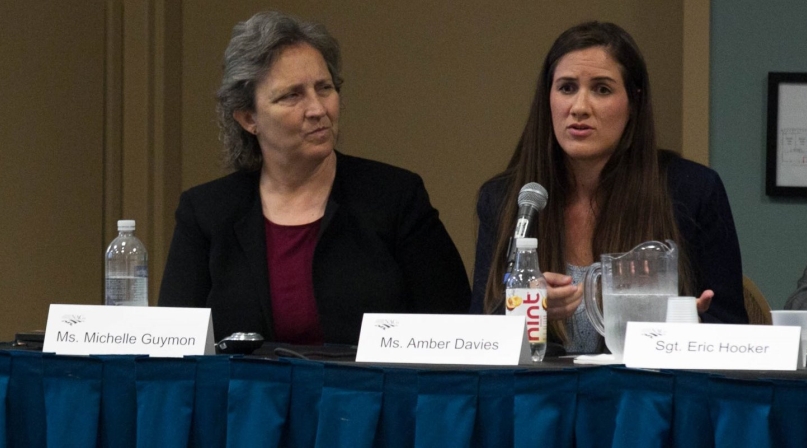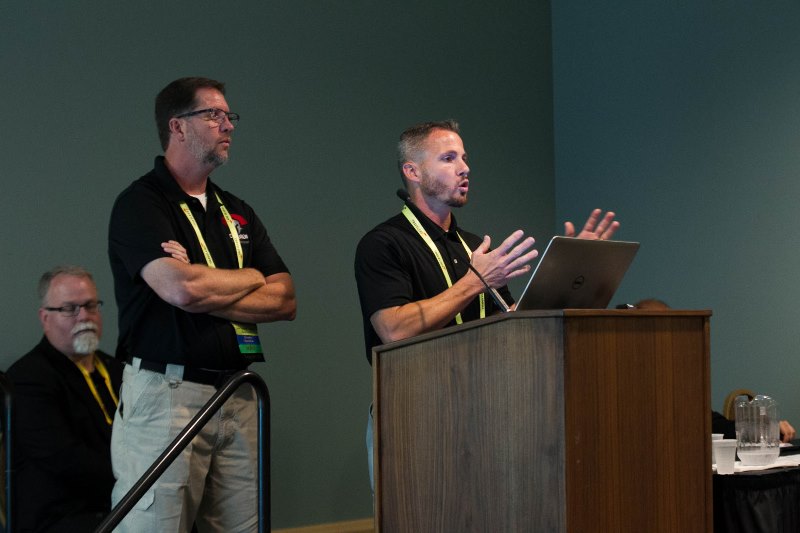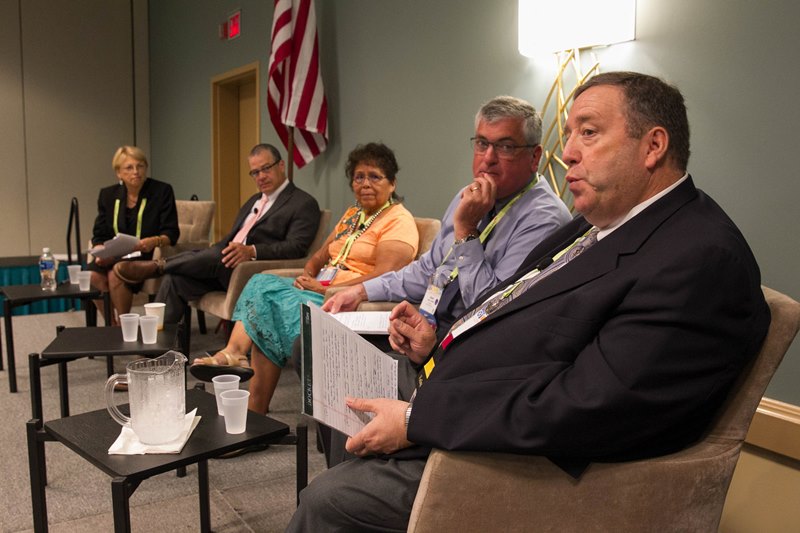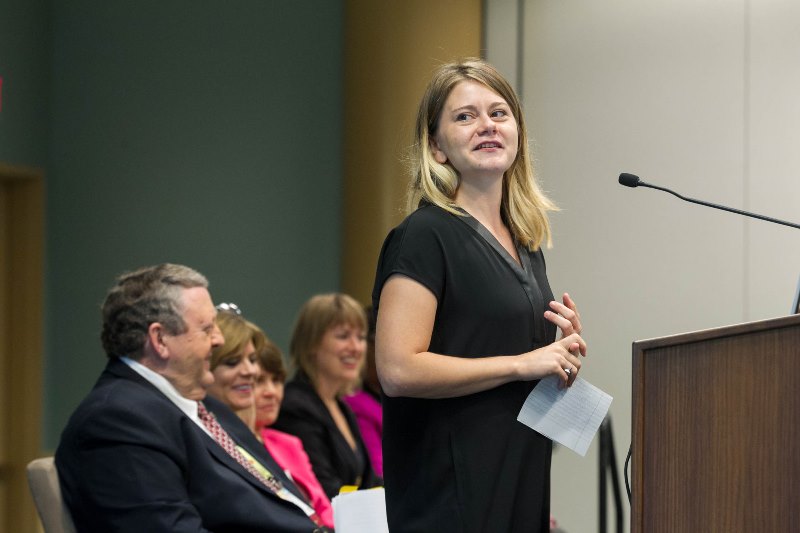Workshops tackle hard subjects

Identifying and Preventing Human Trafficking in Your County
Who spoke:
- Amber Davies, Saving Innocence
- Michelle Guymon, Los Angeles County Probation Department
- Eric Hooker, Long Beach Police Department
What participants learned:
While Los Angeles County gets to play host to the annual conference, Supervisor Don Knabe has been using the bully pulpit to bring attention to a human trafficking, and the shifts in thinking needed to combat it.
“There’s no such thing as a child prostitute; they’re victims,” he said. “These men aren’t johns, they’re child rapists.
“I always thought this was something that happened overseas, in Thailand, but it’s happening (everywhere).”
Several participants in the system described how things work in L.A. County: that change continues with how the victims are treated, especially by law enforcement.
“We were doing broken-window theory, making arrests, and we thought we were doing a fantastic job,” Hooker said. “The arrests are what we were looking for, but now instead of arresting them, we talk to them and see what happens. We tell them, ‘We want to help you and see where we can take you from here.’”
Los Angeles County adapted its human trafficking protocol from a model in place in Washington state.
“California isn’t a decriminalization state, but we wanted to treat this with a non-criminal response,” Guymon said. “We decided that social service agencies would have 90 minutes to respond when an officer calls, and we try to honor that to show the victims that we will do what we say.”
And it’s necessary to have involvement from other departments and agencies, such as the nonprofit Saving Innocence, which supplies victims with supplies and advocates to accompany them for up to nine months after they are removed from the trafficking environment.
Davies said with the social workers spending most of their time coordinating services for the victims, Saving Innocence fills in a gap.
“This isn’t the work of convenience,” she said. “Sometimes the difference is made at 2 a.m. We have to show up at all hours. When they need somebody, us being there is what makes the difference, that’s how they can start being able to make trusted relationships.”
Staff contact: Kathy Rowings, krowings@naco.org

Darry Stacy and Todd Gibson stress the importance of training all county employees to handle active shooter situations: Make any employee a potential leader in an emergency. Photo by David Hathcox
Best Practices in Active Shooter Preparedness
Who spoke:
- Tom Connell, senior product manager Tyco Fire Protection Products
- Todd Gibson, retired Norman Oklahoma swat team officer; partner, Centurion Security
- Robert Kagel, director of emergency services, Chester County, Pa.
- Darry Stacy, commissioner, Cleveland County, Okla.
- James Overton, chief of police for the University of Massachusetts at Boston
What participants learned:
Mass shootings happened in the old days, just not as frequently. And now they’re rightfully on the top of many minds in county government.
“If you don’t train, it could the be end of your county as you know it,” Stacy said.
Connell pointed out that the last 17 years have seen as any casualties of mass violence as the prior 100.
But he kept it in perspective.
“Just .03 people out of 100,000 people will die in an active shooter incident,” he said. That said, “There is no way we can stop every person who really sincerely wants to do harm to his fellow man. We can prepare, we can plan how we’re going to respond, how fast, how effectively. In that response we can save lives that otherwise would have been lost.”
That response has to be focused inward, Stacy said, “When things happen in seconds, the police are minutes away.”
Kagel said counties should address the aftermath of an active shooter incident
“After two or five minutes, how are you going to bring structure to chaos?” he said. “What happens after the threat has been neutralized?”
He recommending designating shelter-in-place locations, developing reunification plans for staff, family assistance services and ensuring continuity of government operations
Overton said getting facts out ahead of the media is important, which he saw when one of the Boston Marathon bombers was erroneously reported to have been a student at his campus.
Gibson said the lowest level county employees have to be as well-trained as the commissioners, to the point where they can be the leaders if members of the public are trapped during an active shooter incident.
“The police officer certainly knows what to do,” he said, but does the administrative assistant on the second floor know?
Staff contact: Tony Jamison, tjamison@naco.org

“Reporter” Carolyn Marinan, Hennepin County, Minn., fires tough questions at county officials during a mock press conference at the workshop, Are You Prepared for a Media Storm?
Are You Prepared for a Media Storm?
Who spoke:
- Lori Hudson, communications and PR manager, Hillsborough County, Fla.
- Jessica Beyer, Blue Earth County, Minn.
What participants learned:
A mock press conference highlighted the workshop. After Hudson advised attendees on how to respond in an emergency scenario, two guinea pigs volunteered to undergo a brief media training before fielding questions from pretend reporters.
Hudson had stressed to importance of preplanning for the type of known emergencies a county might face, from hurricanes to sinkholes to mass shootings. The workshop was conducted by the National Association of County Information Officers.
Among the keys to responding during a crisis are having the right messenger in the right place at the right time.
Other advice included:
• First, express sympathy and concern for the victims and their families.
• Stay in your lane; don’t answer questions that rightly should be answered by someone with the proper expertise.
• Be prepared with the information you anticipate that reporters will ask about, such as the number of victims, extent of damage (if known or when known), protective actions for citizens and where residents can find assistance such as shelter.
• Determine the 3-4 key points you want to communicate to the media. Know in advance the things you won’t say, things you‘ll say if asked and things you will not say, such as speculating about “what if” questions.
• Write out your key messages, practice speaking them out loud, and practice staying on-message.
NACIO has resources available for county public information officers and spokespersons at www.nacio.org.
Staff contact: David Jackson, djackson@naco.org

Mary McCarty, a former Florida county commissioner, tells the cautionary tale of how she unwittingly ran afoul of the law.
Ethical Leadership: Lessons Learned to Keep You Out of Prison
Who spoke:
- Mary McCarty, Mary McCarty Consulting
- Denise Nieman, county attorney, Palm Beach County, Fla.
- Herb Thiele, county attorney, Leon County, Fla., National Association of County Civil Attorneys
What participants learned:
“Disclose, disclose and disclose some more” is the advice that McCarty, a former Palm Beach County Commissioner, gave county leaders. “The more you put on the public record, the more you’re protected.”
She learned the hard way. In 2008, McCarty pleaded guilty to federal charges of honest services fraud and was sentenced to 42 months in prison, of which she served 22 months.
“One thing that I know was that ignorance of the law is not a defense,” she said. “What I didn’t know was how many laws there were that you could be ignorant of.”
She believed that when she voted on an issue that benefited the company her husband worked for — but didn’t directly benefit her spouse — that there was no conflict of interests to disclose.
Speakers said that since 1985, Congress has systematically been doing away with the requirement for “criminal intent” in honest services fraud and other ethics violations.
“I always thought you needed to have committed a crime to be guilty of one,” McCarty said. “I may have been stupid; I may have been careless, but I knew that I never ever set out to commit a crime.”
During a question and answer session, a former prosecutor and district attorney said public officials are often the target of overzealous prosecutors. “As a former prosecutor,” he said, “I can tell you there is a tendency (for some) to want to be known in the papers for prosecuting and going after public corruption, and I’ve seen overzealousness — not by all but by some — and so there is a target on your back.”
Staff contact: Akera Gamble, agamble@naco.org


Panelists listen as Gary Shelton (right), Scott County, Minn. administrator, recounts his county’s successes in building a mutually beneficial relationship with a local Native American tribe.
Building Effective County-Tribal Relations
Who spoke:
- Michael Black, U.S. Bureau of Indian Affairs
- Genevieve Jackson, commissioner, McKinley County, N.M.
- David Rabbit, supervisor, Sonoma County, Calif.
- Gary Shelton, administrator, Scott County, Minn.
What participants learned:
Elected and appointed county officials shared their approaches to successfully working with Native American tribal governments within their counties. They also recommended strategies that might work for other communities.
Shelton provided examples of successful collaboration with the Shakopee Mdewakanton Sioux Community in Scott County, Minn., where he is county administrator. The county and tribe worked together realign a road to better accommodate the tribe’s plan to build a housing development. The parties reached a mutually agreeable solution whereby the county would pay to build the road and the tribe would pay to maintain it.
Shelton said that having a good working relationship with the tribe before the road issue came up was one of the keys to their success.
“It’s very important to build those relationships when there aren’t any issues,” he added, “That kind of ongoing and active intergovernmental engagement will not only improve the communication and cooperation, but it can help you to address misunderstandings … that may have developed over the years.”
Scott County and tribal leaders meet at least monthly, along with all cities and towns in the county, school districts, state lawmakers and field staff from their representative in Congress, he said.
There are five federally recognized tribes in his county and two casinos, Rabbit said. “Our history has been mixed. I think initially we had some adversarial relationships, a lot of that was due to gaming. But since then, I think we’ve really come to grips with sitting down and working through relationships … and forming intergovernmental agreements that benefit both parties.”
Staff contacts: Mike Belarmino, mbelarmino@naco.org, Emilia Istrate, eistrate@naco.org

Whitney Lawrence talks about supportive housing options available for persons with mental illness. Photo by David Hathcox.
Stepping Up: Key Considerations for Reducing Mental Illness in Jails
Who Spoke:
- Vera Bradford, Los Angeles County, Calif.
- Corrin Buchanan, diversion and reentry housing director for the Los Angeles County Health Agency
- Whitney Lawrence, program manager for Community Supportive Housing- LA
- Brooke Page, assistant manager, Clark County, Nev. Social Service
- Colette Tvedt, director of public defense training, National Association of Criminal Defense Lawyers
What participants learned:
The national Stepping Up initiative is now in its second year, and gaining support, with more than 300 counties passing resolutions to seek ways to reduce the number of people with mental illness in their jails.
Speakers focused on the importance of a supportive environment in which people with mental illness will land after being released or diverted from jails.
Tvedt pointed out that many of the charges the mentally ill face are misdemeanors, which don’t come with public defenders.
“They’re convinced to plead guilty because they’re told they can go home that day,” she said.
“Now they have convictions on their records, they have to pay fines and penalties and if they can’t, they have to go to jail.”
She added that they might then be facing long odds to get decent housing.
Instead, as Lawrence said, they bounce around the most expensive, and least appropriate, services a county offers, rarely getting the right treatment they need.
Buchanan said that that supportive housing must be an integral part of any diversion plan, along with a coordinated release plan.
“Recuperative care housing, medically-enhanced housing, stabilization housing, they all offer different levels of support for people with mental illness,” she said. “It can be hard to find landlords who are into renting to people who were formerly homeless.”
Staff contact: Nastassia Walsh, nwalsh@naco.org
Creating Connected Behavioral Health Systems
Who spoke:
- Michelle Bennyhoff, County Behavioral Health Directors Association of California
- Eric Brown, president and CEO, California Telehealth Network
- Chuck Ingoglia, National Council for Behavioral Health
- Dr. Monica Roots, Teladoc Behavioral Health
What participants learned:
The telemedicine “train has left the station,” according to Brown, especially as pertains to long-distance behavioral health diagnoses, treatment and consultations via electronic technology.
Bennyhoff said that telehealth is growing at the rate of about 200 percent annually.
Brown, whose agency serves as California’s telehealth resources center, said 24 states are in the process planning to implement community behavioral health clinic pilots.
Roots, who practices telemedicine, said the key issue in behavioral health is access, but there aren’t enough providers to meet the need. Not everyone is willing to go to a mental health center; telehealth can address that.
“We really need to meet people where they’re at. They want to be able access the care that they want, how they want it, when they want it and the kind of treatment they want,” she said.
Ingoglia said a recent report from the Agency for Healthcare Research and Quality concluded that behavioral telemedicine can be as effective as in-person visits.
Staff contact: Michelle Price, mprice@naco.org.
Attachments
Related News

CMS requires state Medicaid suspension upon arrest versus termination
Effective January 1, 2026, federal law now requires states to suspend, rather than terminate, Medicaid coverage when an individual is incarcerated.

U.S. Congress releases minibus funding package
U.S. House and Senate appropriators introduced a “minibus” appropriations package containing Fiscal Year (FY) 2025 Interior-Environment, Commerce-Justice-Science and Energy-Water spending bills.
